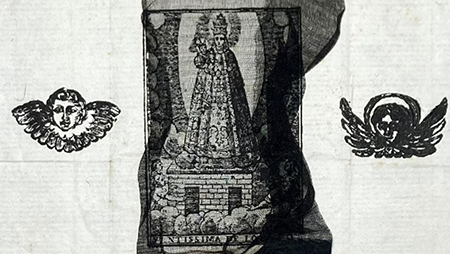Search for books, articles, and more
Mourning Veil Relic from the Holy House of Loreto

Pilgrimage Certificate with Madonna of Loreto Contact Relic. Basilica della Santa Casa, Loreto, Italy. Signed 24 March 1736. Venice: Appresso Alvise Valvasense à S. Mosè in Frezzaria. Black gauze contact relic affixed with wax and paper seal.
Submitted for adoption by Earle Havens, PhD
The Basilica della Santa Casa (Basilica of the Holy House) is a shrine in Loreto, Italy, where the house in which the Virgin Mary is believed to have lived is preserved. It has been a Catholic pilgrimage destination since at least the 14th century. The statue of Our Lady of Loreto enshrined in the Holy House is a black Madonna carved from Cedar of Lebanon and, like the Holy House itself, has a miracle-working reputation.
This holy pilgrimage souvenir signed in March 1736 has a (duly certified) fragment of the black gauze mourning veil worn by the statue during Holy Week to cover the basilica’s much-venerated cult statue of the Virgin and Child. These fabric fragments were prized not only as souvenirs, but also as wonder-working relics originating from arguably the most famous pilgrimage destination in all of early modern Europe. After Easter the veil would be cut up into little pieces and distributed among the pilgrims as relics—a custom that continues today.
The letterpress text on the certificate attests that the attached veil fragment covered the statue of the Virgin and Child on Maundy Thursday and Good Friday, and that it also touched the Holy Dress of the Virgin and the Holy Bowl, two other powerful relics kept in the Holy House.
At the center of the sheet is a woodcut of the cult statue being transported atop the Virgin’s original house in Palestine. The custodian indicated that the certificate was given “Gratis” or free of charge, wrote the date on which the relic was certified, “24 Marzo 1736,” and signed his name and title: “Gioseppe Santoni Custode della S.a Casa.”
No other examples of this contact relic broadside are recorded, making this a unique survival of popular Roman Catholic veneration.

The story of the Santa Casa ranks among the more unusual legends from the Middle Ages. The house in Nazareth—where the Virgin was born and later conceived Jesus through the Holy Spirit—was carried in 1291 by angels to Tersatto (now Trsat, Croatia). In 1294, angels carried the House across the Adriatic to a grove near Ancona. It then was removed in 1295 to a hill near Recanati and then less than a year later to nearby Monte Prodo, not far from Loreto. In 1296, the Santa Casa was at last moved to its present location. It became one of the most popular pilgrimages sites in Christendom.
The veil fabric given to Loreto pilgrims is an example of a “touch relic” (also called “contact relics” and “secondary relics”), that is to say an object, in this case a veil, that came in direct contact with a saint’s primary relic (e.g., a body part or personal item owned by the saint). Other pilgrim-oriented touch relics from Loreto include engraved “envelopes” containing dust from the Holy House, as well as replicas of the Holy Bowl made of clay to which such dust was added. Examples of both are also held in the Sheridan Libraries’ Women of the Book Collection.
To learn more, see Karin Vélez, The Miraculous Flying House of Loreto: Spreading Catholicism in the Early Modern World. Princeton University Press, 2018.